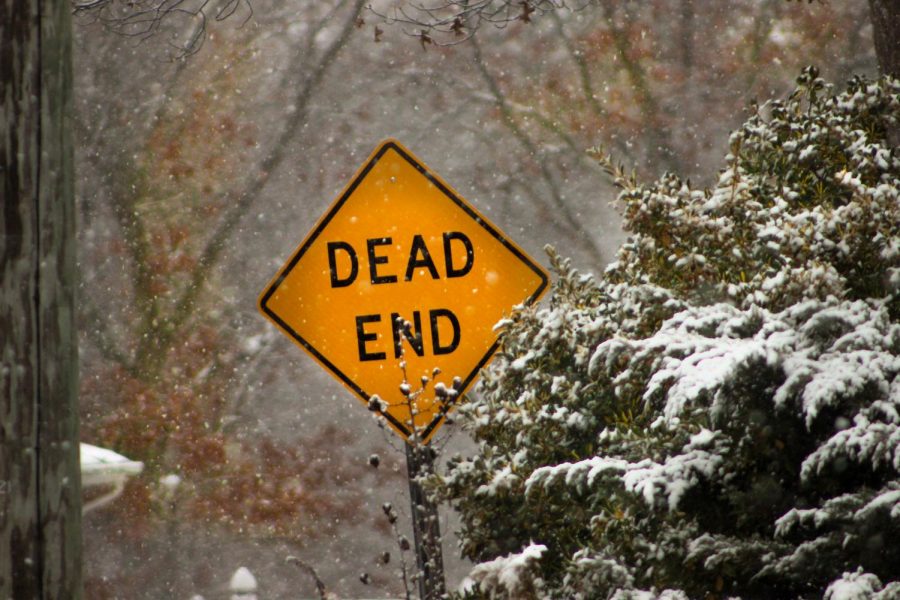Winter Blues: Are They Making You SAD?
Thinking about onset seasonal affective disorder
Photo by Elizabeth Niemiec
For sufferers of winter-onset seasonal affective disorder, winter can feel like a dead end.
It’s January and you’re laying in bed, cocooned in a blanket burrito, and listening to Pink Floyd’s entire discography on repeat. While David Gilmour’s dreamy guitar riff in “Time” usually might leave you amazed and inspired, it leaves you disillusioned and depressed. Thinking about the numerous things you need to do today only makes you want to burrow deeper into the warm and cozy blankets. You find yourself becoming tired even if you had a full night’s sleep the night prior, eating more, and losing interest in activities you usually love.
It seems that everything becomes a little harder in these winter months. It’s harder to get out of bed, harder to make plans that aren’t affected by the weather, and harder to find motivation to do anything when it’s -3 degrees outside. It feels that life weighs you down a lot more than those three winter coats do.
Fortunately, if you experience these mood changes around winter time, it should ease your worries to be told that you’re not the only one. These winter blues have a name: seasonal affective disorder.
So, what is seasonal affective disorder, or SAD? SAD is a type of depression that’s related to changes in seasons, beginning and ending at roughly the same times annually. Psychiatrists have claimed SAD to be a subclass of both generalized depression and bipolar disorder. There are many theories to why the season affects people’s moods, but most can be traced back to lack of light and the circadian clock. Reduced sunlight may cause a drop in serotonin levels, a brain chemical that affects mood, and melatonin levels, a hormone that plays a role in your sleep-wake cycle. These winter blues are linked to shortened days and lengthened nights, and are much more common among people who live further away from the Equator.
While SAD is frequently dubbed as the “winter blues,” many people also suffer from this during the summer months. The summer-onset and winter-onset seasonal affective disorder share many of the same symptoms, but vary in a few of them. For example, many people who suffer from winter-onset SAD crave carbohydrates, leading to weight gain, while those who suffer from summer-onset SAD tend to have poor appetite, leading to weight loss.
So, how do we get over these winter blues?
Hibernation sounds like a great idea; let’s sleep during January and February and pick life back up in mid-March. Complications arise, however, after the third bomb cyclone of the year and you can’t open your front door thanks to the 12 feet of snow outside after you kept procrastinating shoveling your driveway and cleaning off the cars. It wasn’t like you were going to use the car anyway; it’s pointless to clean them off, you said. Though, now that you’re forced to stay indoors and it isn’t your choice to make anymore, you’re not very happy with this idea. So, maybe hibernation’s out of the question.
Go outside! Spend some time in the single digit degree weather! Make sure to bundle up! Nothing brightens a person’s mood more than frostbite.
Make a playlist full of Sagittarians, Capricorns, Aquarians, and Pisceans. You can’t be sad if you’re listening to Britney Spears (Sagittarius) or Rihanna (Pisces) on repeat all winter.
Move to Florida. Can’t experience the winter blues if there’s no winter!
Other treatments that are recommended by doctors are light therapy, which is the most effective for winter-onset SAD; medications; psychotherapy or cognitive behavioral therapy; and mind-body connection techniques such as yoga, meditation, guided imagery, and music or art therapy.
If symptoms of seasonal affective disorder become worse, it can lead to complications. If you are experiencing extreme symptoms, it’s best to skip the DIY light therapy box and talk to your doctor.
(If you’re feeling severely depressed and hopeless and/or have thoughts of suicide, it’s important to contact a health care professional for medical assistance and to call the National Suicide Prevention Hotline at 1-800-273-8255.)
The best thing to do if you don’t feel like investing in a light therapy box? Keep up on regular exercise and socializing. Take a walk outside. Don’t let the winter keep you from enjoying the things you love to do most.

Adelphi Quill Award Winner - 3rd Place, Most Outstanding Reporter (2018)
Grade 12
"You can never be overdressed or overeducated." - Oscar Wilde

Grade 12
"What a wonderful thought it is that some of the best days of our lives haven't happened yet." - Anne Frank









